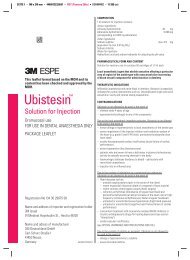EU HRT Core SPC update
EU HRT Core SPC update
EU HRT Core SPC update
You also want an ePaper? Increase the reach of your titles
YUMPU automatically turns print PDFs into web optimized ePapers that Google loves.
globulin (CBG). Only 3-5% of the total serum drug concentrations are present as free steroid.<br />
The mean apparent volume of distribution of drospirenone is 3.7-4.2 l/kg.<br />
Metabolism<br />
Drospirenone is extensively metabolized after oral administration. The major metabolites in the<br />
plasma are the acid form of drospirenone, generated by opening of the lactone ring, and the<br />
4,5-dihydro-drospirenone-3-sulphate, both of which are formed without involvement of the P450<br />
system. Both major metabolites are pharmacologically inactive. Drospirenone is metabolized to<br />
a minor extent by cytochrome P450 3A4 based on in vitro data. In vitro and clinical studies do<br />
not indicate an inhibitory effect of DRSP on CYP enzymes after administration of Angeliq.<br />
Elimination<br />
The metabolic clearance rate of drospirenone in serum is 1.2-1.5 ml/min/kg showing an<br />
intersubject variability of about 25%. Drospirenone is excreted only in trace amounts in<br />
unchanged form. The metabolites of drospirenone are excreted with the faeces and urine at an<br />
excretion ratio of about 1.2 to 1.4. The half-life of metabolite excretion with the urine and faeces<br />
is about 40 hours.<br />
Steady-state conditions and linearity<br />
Following daily oral administration of Angeliq, drospirenone concentrations reached a steadystate<br />
after about 10 days. Serum drospirenone levels accumulated by a factor of about 2 to 3<br />
as a consequence of the ratio of terminal half-life and dosing interval. At steady-state, mean<br />
serum levels of drospirenone fluctuate in the range of 14–36 ng/ml after administration of<br />
Angeliq. Pharmacokinetics of drospirenone are dose-proportional within the dose range of 1 to<br />
4 mg.<br />
Estradiol<br />
Absorption<br />
Following oral administration, estradiol is rapidly and completely absorbed. During the<br />
absorption and the first liver passage, estradiol undergoes extensive metabolism, thus reducing<br />
the absolute bioavailability of estrogen after oral administration to about 5% of the dose.<br />
Maximum concentrations of about 22 pg/ml were reached 6-8 hours after single oral<br />
administration of Angeliq. The intake of food had no influence on the bioavailability of estradiol<br />
as compared to drug intake on an empty stomach.<br />
Distribution<br />
Following oral administration of Angeliq only gradually changing serum levels of estradiol are<br />
observed within an administration interval of 24 hours. Because of the large circulating pool of<br />
estrogen sulphates and glucuronides on the one hand and the enterohepatic recirculation on<br />
the other hand, the terminal half-life of estradiol represents a composite parameter that is<br />
dependent on all of these processes and is in the range of about 13-20 hours after oral<br />
administration.<br />
Estradiol is bound non-specifically to serum albumin and specifically to SHBG. Only about 1-<br />
2% of the circulating estradiol is present as free steroid, 40-45% is bound to SHBG. The<br />
apparent volume of distribution of estradiol after single intravenous administration is about<br />
1 l/kg.<br />
Metabolism<br />
Estradiol is rapidly metabolized, and besides estrone and estrone sulphate, a large number of<br />
other metabolites and conjugates are formed. Estrone and estriol are known as<br />
pharmacologically active metabolites of estradiol; only estrone occurs in relevant<br />
concentrations in plasma. Estrone reaches about 6-fold higher serum levels than estradiol. The
















